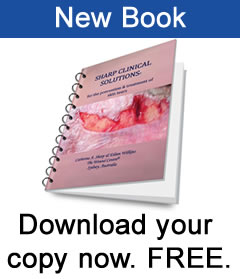At last! A pressure ulcer free aged care facility!
Preventing pressure ulcers in aged care by auditing, and changing, work practices
https://doi.org/10.3126/ajms.v13i4.41855
Abstract
Background: Two nurse consultants concerned with ongoing pressure ulcer development in a 44-bed residential aged care facility in Sydney, Australia, audited pressure ulcers and the use of air mattresses.
Aims and Objectives: To measure and reduce the prevalence of pressure ulcers; audit air mattresses in use; reduce the physical workload for care staff repositioning residents; introduce an alternating pressure air mattress, allow residents to sleep undisturbed, and provide bedside education for all nursing staff.
Materials and Methods: Pressure ulcer prevalence was determined, “air” mattresses were inspected, and repositioning regimes were considered. All residents at risk of pressure ulcers were provided with a “Nodec A” mattress, allowed to sleep undisturbed, and bedside training was given to staff.
Results: Pressure ulcer prevalence was 18.1%. Eight of 44 residents had a total of 10 pressure ulcers; four sacral, three heel ulcers, two buttocks, and one hip. An audit of “air” mattresses showed half, seven of 14 (50%), was not working. Four alarm lights were on; two were set on static mode and one was deflated. Six months after the introduction of the “Nodec A” alternating pressure air mattress all pressure ulcers had healed, and the facility was pressure ulcer free.
Conclusion: Residents nursed on the “Nodec A” were pressure ulcer free and slept for hours without being repositioned and woken.
Post-polio syndrome may decrease mobility and increase risk of pressure ulcers
Post-polio syndrome (PPS) symptoms may include fatigue, muscle weakness and decreased mobility. Decreased mobility renders people at risk of developing pressure ulcers (PU) if they are unable to reposition themselves.
As the world celebrates the highly successful polio eradication program, the challenge to maintain high vaccination rates around the world remains. There is also a growing need for health professionals with the knowledge to adequately treat the estimated 20 million people who are survivors of polio, 400,000 of which are in Australia.
The Australasia-Pacific Post-Polio Conference on 20 – 22nd September 2016 aims to address these challenges, and exchange knowledge about the diagnosis, treatment, and management of the post-polio condition across different age groups.
Focussed on the theme “Polio – Life Stage Matters”, the conference will be a platform for both polio survivors and health care providers to share research results and gold standard evidence-based clinical practise. As care for polio survivors involves many different disciplines, the three day conference will target professionals in the fields of rehabilitation medicine, allied health, nursing, neurology, orthopaedic surgery, and virology, as well as students in these areas.
The conference will be hosted by Polio Australia – the peak national body representing Australia’s polio survivors. Through this conference, Polio Australia will continue their mission to standardise quality information and service provision across Australia. This will work to ensure polio survivors have access to appropriate health care and the support required to maintain independence and make informed lifestyle choices.
Polio Australia has recruited a wide range of experts with a collectively broad skill set and experience base to contribute to the 2016 Australasia-Pacific Post-Polio Conference. Keynote speakers include physiatrist William DeMayo, director of Post-Polio Health International USA Joan Headley and Antonio Toniolo, virologist from Italy.
The program is close to being finalised, and delegate registration is now open at www.postpolioconference.org.au.
For more information, please contact
Melanie Robertson
Marketing Manager, Interpoint Events.
Email melanie@intermedia.com.au
Phone (02) 9660 2113
The shocking sound of…
…your patient crashing to the ground in the shower cubicle…and the bloodcurdling screams!
You took your patient to the shower, made sure she had everything, shampoo, soap, towels… ‘Just wait for me – I’ll come and take you back to your bed,’ you call as you hurry off to answer the buzzer of another patient. What just happened? She said she felt dizzy and slipped on the wet shower floor.
It could be the dementia, the diabetic peripheral neuropathy (numb feet) or the pain-killing medication she had this morning, or a combination of everything.
Can Slips, Trips and Falls be avoided?
Click on the link to ‘Slips, Trips and Falls: The ‘Nurse you’re killing me’ series’ http://www.amazon.com/Slips-Trips-Falls-Nurse-killing-ebook/dp/B00HJAAHLQ 2013 (# 1 best seller in personal injury law) and
Sharp Clinical Solutions for the Prevention of Falls 2014 https://www.amazon.com/dp/B00P8F83HO or copy and paste in your browser. Could this have been avoided? In all probability it could have been… We just have to get rid of silly nursing rituals that put patients at risk of falling… Read about the alternatives in my books.
Slips, Trips and Falls: The ‘Nurse you’re killing me’ series.
My latest book “Slips, Trips and Falls: The ‘Nurse you’re killing me’ series. ASIN:BOOHJAAHLQ” has just been rated a # 1 best seller on Amazon. I am thrilled and delighted & really wanted to share this with you!
Click on the link or go to www.amazon.com copy and paste “Slips, Trips and Falls: The ‘Nurse you’re killing me’ series. ASIN: BOOHJAAHLQ by Catherine A. Sharp” into the search bar.
You may also like to look at the companion book ‘Pressure Sores: The ‘Nurse you’re killing me’ series.
Here’s wishing you all a happy 2014 with no adverse events in your healthcare facility.

